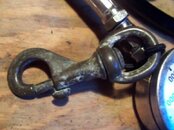Likely PVD becomes the coating, and we continue onward with brass. As to lenses, there is pluses and minuses of each..
You are using an out of date browser. It may not display this or other websites correctly.
You should upgrade or use an alternative browser.
You should upgrade or use an alternative browser.
Brass and glass for SPG. Why?
- Thread starter geoff w
- Start date
Please register or login
Welcome to ScubaBoard, the world's largest scuba diving community. Registration is not required to read the forums, but we encourage you to join. Joining has its benefits and enables you to participate in the discussions.
Benefits of registering include
- Ability to post and comment on topics and discussions.
- A Free photo gallery to share your dive photos with the world.
- You can make this box go away
Thanks for all the replies. So basically, it's environmentally-unfriendly plating on materials and technologies dating back to steam locomotives, not necessarily accurate, but reasonably reliable and durable. I personally wouldn't trust electronics for something as critical as an SPG, but it's clear from the comments that brass and glass are good enough, even though there might be better material options
Except for the environmental jab, I like your summary a lot. If you think about it, the brass-and-glass SPG is exactly the kind of thing that would appeal to technical divers: more than up to the rigors of the task, more than time-tested, more than accurate enough, and not pointlessly over-designed/costly.
- Messages
- 20,693
- Reaction score
- 15,278
- # of dives
- I'm a Fish!
for those that aren't familar
PVD=polymer vapor deposition i.e. powder coating, this removes the chemicals involved in the chroming process, is environmentally friendly, and is actually more durable than traditional chrome...
regarding accuracy, keep in mind that everything in scuba is measured with a micrometer, marked with a crayon, and cut with an axe. The current SPG's are more than accurate enough and are still the preferred gauges for all sorts of industrial applications over digital gauges. Only big advantage to digital gauges would be in CCR type applications where the dil and O2 could plug into digital sensors in the head and display on the NERD. These aren't mission critical for gas planning and in the event of a sensor or battery death you're terminating the dive anyway and it gets rid of a bit of clutter on your chest which is the advantage, but that is certainly beyond the scope of this.
PVD=polymer vapor deposition i.e. powder coating, this removes the chemicals involved in the chroming process, is environmentally friendly, and is actually more durable than traditional chrome...
regarding accuracy, keep in mind that everything in scuba is measured with a micrometer, marked with a crayon, and cut with an axe. The current SPG's are more than accurate enough and are still the preferred gauges for all sorts of industrial applications over digital gauges. Only big advantage to digital gauges would be in CCR type applications where the dil and O2 could plug into digital sensors in the head and display on the NERD. These aren't mission critical for gas planning and in the event of a sensor or battery death you're terminating the dive anyway and it gets rid of a bit of clutter on your chest which is the advantage, but that is certainly beyond the scope of this.
for those that aren't familar
PVD=polymer vapor deposition i.e. powder coating, this removes the chemicals involved in the chroming process, is environmentally friendly, and is actually more durable than traditional chrome.
I don't mean to be that guy and correct you but PVD = Physical Vapor Deposition and can be several different coatings "titanium, chromium, aluminum etc." which is done in a high vacuum environment and is very pure. Powder Coating is basically paint without the solvent so it is powder form and is applied electrostatically and is then baked. PVD coatings as you stated are evironmently friendly.
DaleC
Contributor
- Messages
- 20,693
- Reaction score
- 15,278
- # of dives
- I'm a Fish!
thanks for correction, we use PVD as polymer in my industry when we are doing high end membrane type coatings, should have corrected for that, brain is on work mode, need to get back in the water.... Only 2 weeks till cave country, hallelujah
thanks for correction, we use PVD as polymer in my industry when we are doing high end membrane type coatings, should have corrected for that, brain is on work mode, need to get back in the water.... Only 2 weeks till cave country, hallelujah
Makes sense each industry has they're own spin on processes. I hear ya on getting in the water leaving Friday for two weeks of diving in the Phillipines can't wait for some warm clear water!!
Similar threads
- Locked
- Replies
- 7
- Views
- 561
- Replies
- 3
- Views
- 464
- Replies
- 10
- Views
- 888
- Replies
- 2
- Views
- 1,316





